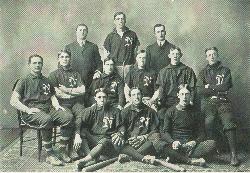

|


Northampton Baseball IV: 1904-1905- Independent Baseball Revives

In 1904 William Kiely, a printer with the Northampton Daily Herald, organized a team as good as any in the city's history. Starring John Wesley Coombs of Colby College, the Northamptons won 41 games, lost 21, and vied with Greenfield in a "championship" series that was decided in Greenfield's favor by one game. Coombs won 20 games for Northampton, striking out as many as 16 players a game.
Coombs was arguably the most gifted ball player to wear a Northampton uniform. (Fred Tenney, the inventive first baseman who played here in 1891, would be his closest rival.) "Colby Jack" pitched for Connie Mack's Philadelphia Athletics, winning 31 games in 1910, 26 in 1911, and 20 in 1912. He won three games in the 1910 World Series and chalked up another World Series victory in 1911. Typhoid fever in his spine put Coombs out of baseball for two full years, but in 1919 he came back with the Brooklyn Dodgers and won his fifth World Series game. After his big league career Jack Coombs went on to coach the Duke University team to national championships and also to write a highly regarded book on baseball strategy.
One moment in Coombs' rookie season hearkened back to his days in Northampton. In 1906, Coombs set the record for most strikeouts in a game by a rookie, 19 (a mark that stood until 1998). Playing the outfield for the opposition Boston Red Sox that day was former Northampton teammate John B. Hoey of Holy Cross. In the bottom of the 18th, with Coombs still on the mound, he intentionally walked the bases full to face Hoey, whose strengths and weaknesses he knew. Coombs struck Hoey out to end the threat, and went on to win the game 4-1, pitching all 24 innings.
In 1905 William Kiely fielded one more independent Northampton team. Hoey returned, but not Coombs, who joined the "outlaw" Northern League in Vermont. In spite of a 12-6 record, the club disbanded in July. Kiely returned to his printing business with the Herald and later became its publisher.
Contents Historic Northampton.